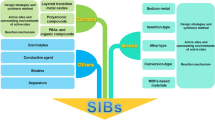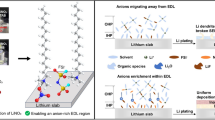Abstract
Sodium-ion batteries are promising new-generation energy storage devices due to the low cost and rich resource of sodium. Among various cathodes, tunnel-type Na0.44MnO2 with large S-shaped Na+ transport tunnels is considered an appropriate cathode for fast-charging batteries, yet still suffering from sluggish Na+ kinetics. Herein, a novel ion-exchange method is developed for the first time to synthesize Na0.44MnO2 from K0.5MnO2 precursor. By precisely adjusting the synthesis condition, the amount of residual K+ and the size of Na0.44MnO2 are well controlled. The presence of trace K+ in the Na0.44MnO2 structure is demonstrated to broaden the Na+ transport tunnels while the minimized size shortens the Na+ migration distance. Besides, band-like defects with distorted polyhedrons further promote Na+ transport. The as-prepared Na0.44MnO2 with intrinsic pseudo-capacitance characteristic exhibits excellent rate performance of 79.0 mA h g−1 at 20 C between 2 and 4 V. Long-term cycling tests present superior stability of 98.1% retention after 1000 cycles at 20 C and 96.3% retention after 200 cycles at 0.5 C. This work provides a novel way for large-scale production of high-rate and robust Na0.44MnO2 cathode for fast-charging energy storage devices.

摘要
钠离子电池因其成本低、 资源丰富等优点而成为新一代储能设备. 在各种正极中, 隧道型Na0.44MnO2因其较大的Na+通道, 被认为是快速充电电池的合适正极材料, 但仍然存在Na+动力学缓慢等问题. 本文首次提出了一种Na0.44MnO2的新型离子交换方法, 通过调节合成条件, 可以很好地控制K+残余量和Na0.44MnO2的尺寸. 结果表明, Na0.44MnO2结构中的残留K+扩大了Na+的输运通道, 小颗粒形貌缩短了Na+的迁移距离, 且晶体中的带状缺陷界面进一步加速了Na+的输运. 获得的Na0.44MnO2具有本征赝电容特性, 在2 – 4 V和2 0 C电流下有79.0 mA h g−1的优异倍率性能. 长期循环测试表明, 20 C下1000次循环的保持率为98.1%, 0.5 C下200次循环的保持率为96.3%. 本工作为用于快速充电储能装置的高倍率、 高稳定性Na0.44MnO2正极的大规模生产提供了一条新途径.
Similar content being viewed by others
References
Sun J, Liu C, Song X, et al. Electrochemical energy storage devices under particular service environments: Achievements, challenges, and perspective. Appl Phys Rev, 2022, 9: 031301
Hameer S, van Niekerk JL. A review of large-scale electrical energy storage. Int J Energy Res, 2015, 39: 1179–1195
Tarascon JM, Armand M. Issues and challenges facing rechargeable lithium batteries. Nature, 2001, 414: 359–367
Kulova TL, Fateev VN, Seregina EA, et al. A brief review of postlithium-ion batteries. Int J Electrochem Sci, 2020, 15: 7242–7259
Usiskin R, Lu Y, Popovic J, et al. Fundamentals, status and promise of sodium-based batteries. Nat Rev Mater, 2021, 6: 1020–1035
Wang K, Zhang Z, Cheng S, et al. Precipitate-stabilized surface enabling high-performance Na0.67Ni0.33−xMn0.67ZnxO2 for sodium-ion battery. eScience, 2022, 2: 529–536
Zhu YF, Xiao Y, Dou SX, et al. Spinel/post-spinel engineering on layered oxide cathodes for sodium-ion batteries. eScience, 2021, 1: 13–27
Wang D, Cai P, Zou GQ, et al. Ultra-stable carbon-coated sodium vanadium phosphate as cathode material for sodium-ion battery. Rare Met, 2022, 41: 115–124
Liu C, Zhang ZX, Tan R, et al. Design of cross-welded Na3V2(PO4)3/C nanofibrous mats and their application in sodium-ion batteries. Rare Met, 2022, 41: 806–813
He M, Davis R, Chartouni D, et al. Assessment of the first commercial Prussian blue based sodium-ion battery. J Power Sources, 2022, 548: 232036
Cao Y, Xiao M, Sun X, et al. Recent advances on high-capacity sodium manganese-based oxide cathodes for sodium-ion batteries. Chem Eur J, 2023, 29
Han MH, Gonzalo E, Singh G, et al. A comprehensive review of sodium layered oxides: Powerful cathodes for Na-ion batteries. Energy Environ Sci, 2015, 8: 81–102
Li X, Shen X, Zhao J, et al. O3-NaFe(1/3−x)Ni1/3Mn1/3AlxO2 cathodes with improved air stability for Na-ion batteries. ACS Appl Mater Interfaces, 2021, 13: 33015–33023
Chae MS, Elias Y, Aurbach D. Tunnel-type sodium manganese oxide cathodes for sodium-ion batteries. ChemElectroChem, 2021, 8: 798–811
Dong W, Xie M, Zhao S, et al. Materials design and preparation for high energy density and high power density electrochemical super-capacitors. Mater Sci Eng-R-Rep, 2023, 152: 100713
Akimoto J, Hayakawa H, Kijima N, et al. Single-crystal synthesis and structure refinement of Na0.44MnO2. SSP, 2011, 170: 198–202
Feng J, Luo S, Cai K, et al. Research progress of tunnel-type sodium manganese oxide cathodes for SIBs. Chin Chem Lett, 2022, 33: 2316–2326
Peng B, Gao J, Sun Z, et al. High performance sodium-ion full battery based on one-dimensional nanostructures: The case of Na0.44MnO2 cathode and MoS2 anode. J Phys D-Appl Phys, 2021, 54: 014001
Hosono E, Saito T, Hoshino J, et al. High power Na-ion rechargeable battery with single-crystalline Na0.44MnO2 nanowire electrode. J Power Sources, 2012, 217: 43–46
Zhao H, Wu L, Tian J, et al. Molten-salt assisted synthesis of a highperformance oxide cathode for sodium-ion batteries: Na0.44MnO2 as a case. New J Chem, 2023, 47: 3892–3902
Liu Q, Hu Z, Chen M, et al. Multiangular rod-shaped Na0.44MnO2 as cathode materials with high rate and long life for sodium-ion batteries. ACS Appl Mater Interfaces, 2017, 9: 3644–3652
Ju X, Huang H, Zheng H, et al. A facile method to hunt for durable high-rate capability Na0.44MnO2. J Power Sources, 2018, 395: 395–402
Zhang W, Seo DH, Chen T, et al. Kinetic pathways of ionic transport in fast-charging lithium titanate. Science, 2020, 367: 1030–1034
Chae MS, Kim HJ, Bu H, et al. The sodium storage mechanism in tunnel-type Na0.44MnO2 cathodes and the way to ensure their durable operation. Adv Energy Mater, 2020, 10: 2000564
Zhang D, Shi W, Yan Y, et al. Fast and scalable synthesis of durable Na0.44MnO2 cathode material via an oxalate precursor method for Na-ion batteries. Electrochim Acta, 2017, 258: 1035–1043
Sheng N, Han C, Lei Y, et al. Controlled synthesis of Na0.44MnO2 cathode material for sodium ion batteries with superior performance through urea-based solution combustion synthesis. Electrochim Acta, 2018, 283: 1560–1567
Pu X, Zhao D, Fu C, et al. Understanding and calibration of charge storage mechanism in cyclic voltammetry curves. Angew Chem Int Ed, 2021, 60: 21310–21318
Zhao Z, Huang X, Shao Y, et al. Surface modification of Na0.44MnO2via a nonaqueous solution-assisted coating for ultra-stable and high-rate sodium-ion batteries. Chem Eng J Adv, 2022, 10: 100292
Xu M, Niu Y, Chen C, et al. Synthesis and application of ultra-long Na0.44MnO2 submicron slabs as a cathode material for Na-ion batteries. RSC Adv, 2014, 4: 38140–38143
Acknowledgements
This work was supported by the National Natural Science Foundation of China (52202327 and 51972326), the Science and Technology Commission of Shanghai Municipality (22ZR1471300), and the Program of Shanghai Academic Research Leader (22XD1424300).
Author information
Authors and Affiliations
Contributions
Author contributions Cao Y conducted the material preparation and characterization, and wrote the manuscript. Xiao M and Cai T participated in the electrochemical tests. Dong W, Bi H and Huang F supervised the study, and participated in writing-review and editing.
Corresponding authors
Ethics declarations
Conflict of interest The authors declare that they have no conflict of interest.
Additional information
Yuge Cao obtained his Bachelor degree in 2021 from the College of Chemistry and Molecular Engineering, Peking University. He is now pursuing his Master’s degree under the supervision of Prof. Fuqiang Huang at the State Key Laboratory of High Performance Ceramics and Superfine Microstructures, Shanghai Institute of Ceramics, Chinese Academy of Sciences. His research focuses on high-performance manganese-based oxide cathodes for sodium-ion batteries.
Hui Bi received his PhD degree from the Northwestern Polytechnical University in 2010. He worked as a research staff at Shanghai Institute of Ceramics, Chinese Academy of Sciences, and then became a professor in 2020. His interests concentrate on the controllable growth of graphene and its applications in lithium-ion batteries, sodium-ion batteries and supercapacitors.
Fuqiang Huang received his PhD degree in chemistry from Beijing Normal University in 1996. In 1996–2003, he worked in the United States as a research staff member at the University of Michigan, Northwestern University, Osram Sylvania Inc. and University of Pennsylvania. He joined the State Key Lab of High Performance Ceramics and Superfine Microstructure, Shanghai Institute of Ceramics, Chinese Academy of Sciences, and became a full professor in 2003. His current research interests mainly focus on designing new energy materials and devices.
Supplementary information Supporting data are available in the online version of the paper.
Rights and permissions
About this article
Cite this article
Cao, Y., Xiao, M., Dong, W. et al. Intrinsic pseudocapacitive Na0.44MnO2 prepared by novel ion-exchange method for high-rate and robust sodium-ion storage. Sci. China Mater. 66, 3810–3816 (2023). https://doi.org/10.1007/s40843-023-2562-7
Received:
Accepted:
Published:
Issue Date:
DOI: https://doi.org/10.1007/s40843-023-2562-7




